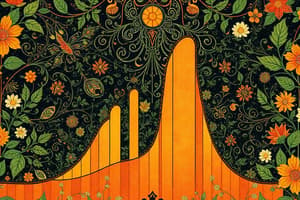Podcast
Questions and Answers
What does standard deviation measure in a data set?
What does standard deviation measure in a data set?
- How close the sample mean is to the population mean
- How spread out the data points are from the mean (correct)
- How large the sample size is
- How many outliers are in the dataset
Which of the following statements best describes standard error?
Which of the following statements best describes standard error?
- It measures how close the data points are to each other
- It indicates how close the sample mean is to the true population mean (correct)
- It calculates the number of standard deviations in a dataset
- It represents the spread of data points from the mean
In statistics, what does it mean if a sample's standard error is large?
In statistics, what does it mean if a sample's standard error is large?
- The sample size is small
- There are no outliers in the data set
- The sample mean is likely far from the population mean (correct)
- The sample mean is closer to the population mean
What is the purpose of calculating standard error?
What is the purpose of calculating standard error?
What does standard deviation measure in a data set?
What does standard deviation measure in a data set?
How is standard error different from standard deviation?
How is standard error different from standard deviation?
In statistics, what does it mean if a sample's standard error is large?
In statistics, what does it mean if a sample's standard error is large?
What does a larger standard error imply about the sample mean's proximity to the true population mean?
What does a larger standard error imply about the sample mean's proximity to the true population mean?
How does a small standard deviation affect the spread of data points in a data set?
How does a small standard deviation affect the spread of data points in a data set?
If a sample has a low standard error, what can be inferred about its representation of the population?
If a sample has a low standard error, what can be inferred about its representation of the population?
What does a small standard error indicate about the accuracy of representing the actual population?
What does a small standard error indicate about the accuracy of representing the actual population?
Что такое наследственность организмов?
Что такое наследственность организмов?
Какие черты образуют фенотип организма?
Какие черты образуют фенотип организма?
Что образует генотип организма?
Что образует генотип организма?
Какое воздействие на появление загара у человека упоминается в тексте?
Какое воздействие на появление загара у человека упоминается в тексте?
Что представляет собой эволюция организмов?
Что представляет собой эволюция организмов?
Что такое аллели?
Что такое аллели?
Что такое геном?
Что такое геном?
Что такое эпигенетические системы наследования?
Что такое эпигенетические системы наследования?
Что означает мутация внутри гена?
Что означает мутация внутри гена?
Что представляют собой экологическое наследование посредством строительства ниши и наследование культурных черт?
Что представляют собой экологическое наследование посредством строительства ниши и наследование культурных черт?
Flashcards are hidden until you start studying
Study Notes
Statistics and Data Analysis
- Standard Deviation: Measures the spread or dispersion of a data set, indicating how much individual data points deviate from the mean.
- Standard Error: Measures the variability of a sample mean, estimating how much the sample mean is likely to deviate from the true population mean.
- Large Standard Error: Indicates that the sample mean is likely to be far from the true population mean, implying a less accurate representation of the population.
- Purpose of Standard Error: To calculate the margin of error, which is essential for making inferences about the population based on a sample.
- Standard Error vs. Standard Deviation: Standard error is a measure of the variability of the sample mean, while standard deviation measures the spread of individual data points.
- Small Standard Deviation: Indicates that the data points are closely clustered around the mean, resulting in a smaller spread of data.
- Low Standard Error: Implies that the sample is a more accurate representation of the population, and the sample mean is closer to the true population mean.
- Small Standard Error: Indicates that the sample mean is a more accurate representation of the true population mean, and the sample is a good representation of the population.
Genetics and Evolution
- Heritability: The passing of traits from parents to offspring through genes.
- Phenotype: The physical and behavioral characteristics of an organism that result from the interaction of its genotype and environment.
- Genotype: The genetic makeup of an organism, consisting of its genes and alleles.
- Genome: The complete set of genes in an organism.
- Epigenetic Systems: Mechanisms that influence gene expression without altering the DNA sequence.
- Mutation: A change in the DNA sequence of a gene, leading to a change in the gene's function or expression.
- Ecological Inheritance: The process by which organisms inherit environmental features, such as niches, that are constructed by their ancestors.
- Cultural Inheritance: The transmission of cultural traits, such as behaviors and knowledge, from one generation to the next.
- Evolution: The change in the characteristics of a population over time, resulting from the interactions of genetic variation, environment, and population dynamics.
- Alleles: Different forms of a gene, which can result in different expressions of a trait.
Studying That Suits You
Use AI to generate personalized quizzes and flashcards to suit your learning preferences.



